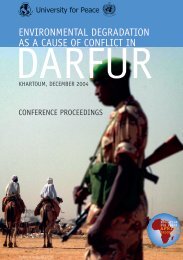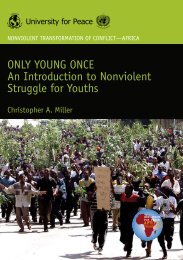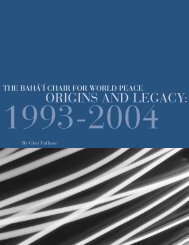who medicines strategy - libdoc.who.int - World Health Organization
who medicines strategy - libdoc.who.int - World Health Organization
who medicines strategy - libdoc.who.int - World Health Organization
You also want an ePaper? Increase the reach of your titles
YUMPU automatically turns print PDFs into web optimized ePapers that Google loves.
COMPONENTS OF THE STRATEGY | 93Figure 23:Global distribution of consumption of morphine in 2001Source: Report of the International Narcotics Control Board for 2002 48Europe (12.2%) • 33%Japan (2.1%) • 6%Australia andNew Zealand (0.4%) • 5%Others (80%) • 5%Canada and the United States (5.3%) • 51%Note:Percentages in brackets refer to shares of the world’s population.Challenges remainingMany new chemical substances with psychoactiveproperties continue to be synthesized, distributed,and abused. These substances should be rapidlydetected, reviewed, and put under <strong>int</strong>ernationalcontrol, as necessary. However, overly restrictiveregulations in many countries on the distributionof psychoactive drugs, including narcotic painkillers, continue to limit their availability, resultingin the suffering of cancer patients and others dueto inadequately treated severe pain or untreatedmental disorders. As the International NarcoticsControl Board has highlighted, significantdifferences exist between countries in the extentto which narcotic drugs are used for the treatmentof pain — with their use in most developingcountries, in particular, at an extremely low level.Meeting the challenges 2004-2007Over the next four years WHO will:> continue to support the Expert Committeeon Drug Dependence by providing clearguidance for the review process.> enhance cooperation with the UNDCP andthe International Narcotics Control Boardand other relevant organizations in collectinginformation on new psychoactive substancesthat could be abused.> continue to advocate and promote the rationaluse of controlled <strong>medicines</strong>, particularlyin developing countries, by facilitating theimplementation of relevant guidelines inMember States.OUTCOME INDICATORS1999 2003 2007No. of substances reviewed and recommended forclassification for <strong>int</strong>ernational control#REPORTING % TARGET#REPORTING % TARGET2/3. 66% na 5/5. 100% 80%











